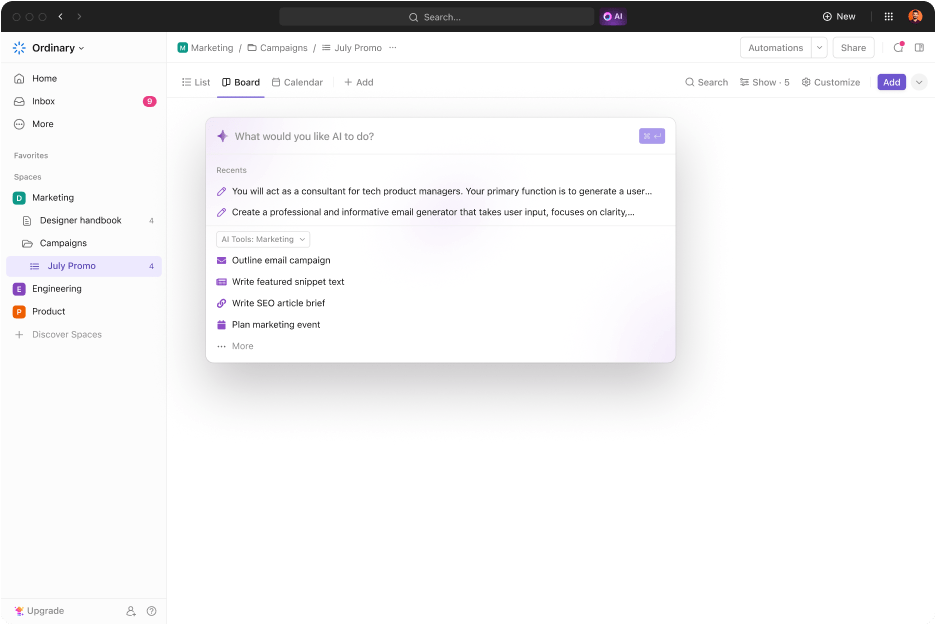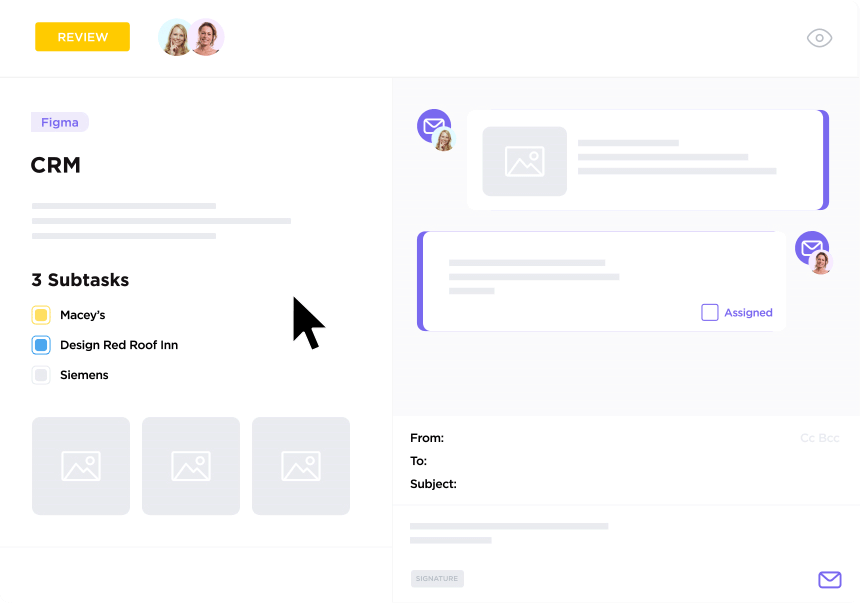Mastering Marketing RFPs: A Comprehensive Guide for Success

Sorry, there were no results found for “”
Sorry, there were no results found for “”
Sorry, there were no results found for “”
Sometimes, you need a little help launching your marketing campaign or bringing an initiative to life. That’s where vendors and external digital marketing agencies come in. These experts can save you time and effort by handling certain aspects of your marketing campaigns that your team doesn’t have the capacity for.
The best way to reach out to these experts is to create a marketing request for proposal (RFP). This document is a simple request form, making it easy to communicate your needs and get the exact services required for the project.
Here, we’ll explain what marketing RFPs are, including key components yours should include. We’ll also offer an easy-to-follow guide to creating a marketing RFP, tips for writing an effective one, and advice for finding the best opportunities. ✨
A marketing request for proposal, or RFP, is a document asking for services that your team can’t handle internally. You may send an RFP because your team is at capacity and can’t take on additional tasks or you may need help from an expert who has knowledge that your team doesn’t.
It’s a key component of most marketing planning processes, especially for teams that need outside resources to get the job done. 📄
You can send your marketing RFP to a specific marketing agency you’re interested in or publish it online as an open application form for broader reach. Typically, vendors respond to the RFP with a general quote, specific services they can offer, and an expected timeframe for deliverables.
An RFP differs from a request for information (RFI) or a request for quotes (RFQ). An RFI is a simpler questionnaire that’s used before an RFP to decide whether vendors should be included on the outreach list. It essentially pre-qualifies companies based on services or budget needs.
An RFQ is a document that requests detailed cost and quote information related to the service being requested in an RFP document. While an RFP asks for an estimated proposal amount, an RFQ is more detailed, with breakdowns of the costs of specific services based on the estimated timeline and scope of work.
Marketing RFPs are an excellent resource for businesses needing extra help with marketing strategy, execution, or outreach. The function of a marketing RFP is to get outside assistance. Not only does this save your team time, but it also builds valuable connections with marketing experts. 🤝
A marketing project can move faster with marketing RFPs. With outside help, you can increase the number of campaigns you run or shift your internal team’s focus to more important marketing projects.
Some benefits of using a marketing RFP include:
By sending an RFP, you can connect with other marketing experts and move projects through the pipeline more efficiently.
Here are some scenarios where marketing agencies may send RFPs:
Every marketing RFP will be different but should contain a standard set of items. The actual information you include or services you’re requesting will change, but you still want to include key details in each document. ✅
Here are the critical components to include in your marketing RFP:
Whether you want marketing communications assistance, seek ad support, or need to launch big campaigns faster, use this guide to create your RFP. Below, we’ll cover everything you need to know to write a marketing RFP, including marketing project management strategies to get the job done.
Make your life easier by using a template—like the Web Development RFP Template from ClickUp—to create the framework of your request. While this template is specifically for marketing teams looking for external web development assistance, you can find templates for all kinds of RFPs.

When choosing an RFP template, make sure it includes the essential components of a good RFP. It should include the sections we mentioned above, like the project overview and basic company information.
Once you have the general structure of the RFP document, you need to fill in all of the relevant details. Work through the document section by section, adding in your specific requests.

Make this step easier using tools like ClickUp AI to automatically fill out key information like your company’s contact details and experience information. Create your RFP in ClickUp Docs, which allows you to collaborate with other team members to draft a more effective request. Use the embed feature to include tables or charts that make your RFP more engaging.
Now that you have your RFP, you’ll want to make it available to potential vendors. You can cast a wide net by publishing the RFP on your site and inviting anyone to apply. Alternatively, you can contact specific agencies you’re interested in working with.
If you choose the latter approach, creating a list of vendors is helpful. With ClickUp’s Marketing features, including customer relationship management (CRM), you can build a database of vendors. Use custom fields in ClickUp’s marketing project management software to qualify potential vendors or indicate their willingness to participate if you’ve already reached out before.

As you send RFPs, document the responses you receive, and create profiles for new vendors with category tags for services they offer—like video production, case studies, or digital marketing services. That way, when it’s time to send a new RFP or request other services, you already have a pool of candidates to contact.
The best way to manage the process is with tools like proposal management software and blueprints like ClickUp’s RFP Process Template. This template keeps your team organized by tracking important due dates—like the submission deadline—and collects responses in one convenient space. 🛠️

Create custom fields to track each proposal, and add priority flags to highlight specific proposals that meet your needs. Various views—including Kanban boards, Calendar views, and Gantt charts—make evaluating all applicants equally and keeping track of progress easy.

ClickUp’s project management features also streamline workflows, thanks to automations that move RFPs through your work pipeline. Add triggers to instantly assign someone on the team to review an application once it’s submitted. Set custom permissions to simplify decision-making and include dependencies to create workflows that show which tasks are blocking the next steps in the review process.
After you’ve selected a vendor, it’s essential to follow up and incorporate a clear messaging plan. You’ll want to reach out to the vendor that won the bid and applicants that didn’t make the cut. Like your other marketing plans and strategies, tailor your response to different categories of applicants.
If you’ve reached out to a handful of providers, you can send a personal email to each one. If you’ve cast a wider net, you can categorize providers as “not qualified,” “qualified but out of budget,” or “qualified but not the right fit.” Based on these categories, you can send tailored email replies to multiple candidates indicating why they weren’t picked.

In your messages, clearly state that all stakeholders appreciated the application and indicate why they weren’t selected. Keep things professional and brief, and include wording if you plan to reach out again for future projects.
If you have services you can offer to other agencies, you can use several channels to find and apply to other company’s RFPs so you can grow your own business. 🙌
Here are some of the best channels and platforms for finding marketing RFPs:
You know how to write an RFP asking for services from vendors, but what about if you want to apply to RFPs with your own offerings? Here, we’ll provide top tips and best practices when crafting a response to a marketing RFP. ✍️
If you want to land clients successfully by applying to an RFP, you need to do some legwork. Before applying, do research on the company. By learning what drives the company, you can tailor your application to precisely what they want. Find out if they’ve sent out RFPs before and who successfully won the bid. Then, try to determine what they did right and replicate that.
It’s also essential to make sure you’re qualified. You don’t want to waste time applying to postings if you can’t meet the requirements. Carefully read and follow all instructions if you do apply, and ask questions if you need clarity.

Here are some examples of successful RFP responses:
Crafting a response to an RFP isn’t just about including relevant information. It’s also important to leave some things out.
Here’s what you should not include in an RFP:
Still want to know more? Here are the most commonly asked questions about RFPs.
This type of RFP is a proposal sent by a company to vendors that offer marketing and branding services.
If you want to apply to marketing RFPs, look on sites like LinkedIn, Twitter, and portals where government agencies and public companies post their proposal requests.
The private sector does not have to make RFPs public. However, government agencies and companies in the public sector are required to list RFPs as public information.
RFPs in marketing and advertising are key tools to get outside expertise to supplement your existing projects. They’re an opportunity to build better campaigns and deliver improved services to your customers, without having to take time away from other internal focuses.
To create a great marketing RFP, it’s important to include key sections, leverage tools like AI to simplify the process, and use software to track responses and store analytics for your campaigns.
Sign up for ClickUp today to start building better marketing RFPs. With built-in AI tools and templates, you can create drafts and outlines for your RFPs in seconds. Paired with project management features and multiple views, it’s easy to manage the RFP process from start to finish. 💪
© 2026 ClickUp